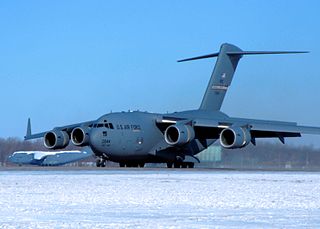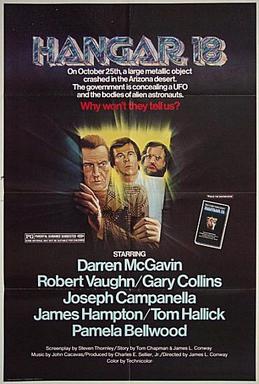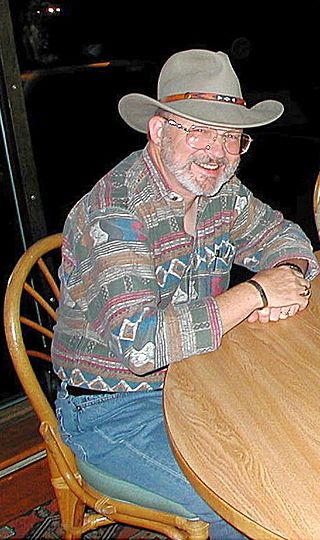Related Research Articles

Alien Autopsy: Fact or Fiction is a 1995 pseudo-documentary containing grainy black and white footage of a hoaxed alien autopsy. In 1995, film purporting to show an alien autopsy conducted shortly after the Roswell incident was released by British entrepreneur Ray Santilli. The footage aired on television networks around the world. Fox television broadcast the purported autopsy, hosted by Jonathan Frakes, on August 28, 1995, under the title Alien Autopsy: Fact or Fiction, and re-broadcast it twice, each time to higher ratings. The footage was also broadcast on UK's Channel 4, and repackaged for the home video market. The program was an overnight sensation, with Time magazine declaring that the film had sparked a debate "with an intensity not lavished on any home movie since the Zapruder film".

Wright-Patterson Air Force Base (WPAFB) is a United States Air Force base and census-designated place just east of Dayton, Ohio, in Greene and Montgomery counties. It includes both Wright and Patterson Fields, which were originally Wilbur Wright Field and Fairfield Aviation General Supply Depot. Patterson Field is approximately 16 kilometres (10 mi) northeast of Dayton; Wright Field is approximately 8.0 kilometres (5 mi) northeast of Dayton.
UFO conspiracy theories are a subset of conspiracy theories which argue that various governments and politicians globally, in particular the United States government, are suppressing evidence that unidentified flying objects are controlled by a non-human intelligence or built using alien technology. Such conspiracy theories usually argue that Earth governments are in communication or cooperation with extraterrestrial visitors despite public disclaimers, and further that some of these theories claim that the governments are explicitly allowing alien abduction.
Grey aliens, also referred to as Zeta Reticulans, Roswell Greys or Grays, are purported extraterrestrial beings. They are frequent subjects of close encounters and alien abduction claims. The details of such claims vary widely, however Greys are typically described as being human-like with small bodies, smooth, grey-colored skin; enlarged, hairless heads; and large, black eyes. The Barney and Betty Hill abduction claim, which purportedly took place in New Hampshire in 1961, popularized Grey aliens. Precursor figures have been described in science fiction and similar descriptions appeared in early accounts of the 1948 Aztec UFO hoax and later accounts of the 1947 Roswell UFO incident.

The Roswell incident is a collection of events and myths surrounding the 1947 crash of a United States Army Air Forces balloon, near Roswell, New Mexico. Operated from the nearby Alamogordo Army Air Field and part of the top secret Project Mogul, the balloon's purpose was remote detection of Soviet nuclear tests. After metallic and rubber debris was recovered by Roswell Army Air Field personnel, the United States Army announced their possession of a "flying disc". This announcement made international headlines but was retracted within a day. Obscuring the true purpose and source of the crashed balloon, the Army subsequently stated that it was a conventional weather balloon.
Dulce Base is the subject of a conspiracy theory claiming that a jointly-operated human and alien underground facility exists under Archuleta Mesa on the Colorado–New Mexico border near the town of Dulce, New Mexico, in the United States. Claims of alien activity there first arose from Albuquerque businessman Paul Bennewitz.

Hangar 18 is a 1980 American science fiction action film directed by James L. Conway and written by Ken Pettus, from a story by Thomas C. Chapman and Conway. It stars Darren McGavin, Robert Vaughn, Gary Collins, James Hampton and Pamela Bellwood.

Many works of fiction have featured UFOs. In most cases, as the fictional story progresses, the Earth is being invaded by hostile alien forces from outer space, usually from Mars, as depicted in early science fiction, or the people are being destroyed by alien forces, as depicted in the film Independence Day. Some fictional UFO encounters may be based on real UFO reports, such as Night Skies. Night Skies is based on the 1997 Phoenix UFO Incident.

Nicholas Redfern is a British best-selling author, journalist, cryptozoologist and ufologist.

In ufology, conspiracy theory, science fiction, and comic book stories, claims or stories have circulated linking UFOs to Nazi Germany. The German UFO theories describe supposedly successful attempts to develop advanced aircraft or spacecraft prior to and during World War II, further asserting the post-war survival of these craft in secret underground bases in Antarctica, South America, or the United States, along with their creators.
Hangar 18 may refer to:
Kevin Douglas Randle is an American ufologist, science fiction and historical fiction writer and a military veteran. Within the UFO community, he is often regarded as one of the preeminent experts on the reported crash of a UFO near Roswell, New Mexico in July 1947.

The Day After Roswell is an American book about extraterrestrial spacecraft and the Roswell incident. It was written by United States Army Colonel Philip J. Corso, with help from William J. Birnes, and was published as a tell-all memoir by Pocket Books in 1997, a year before Corso's death. The book claims that an extraterrestrial spacecraft crashed near Roswell, New Mexico, in 1947 and was recovered by the United States government who then sought to cover up all evidence of extraterrestrials.
Robert Spencer Carr was an American writer of science fiction and fantasy. He sold his first story to Weird Tales at age 15. At age 17 his novel, The Rampant Age, became a success resulting in a movie contract.

Karl Tomlinson Pflock was a CIA intelligence officer, Deputy Assistant Secretary of Defense in the Reagan Administration, strategic planner, UFO researcher, and author of both fiction and non-fiction. He was best known for his book Roswell: Inconvenient Facts and the Will to Believe.

The Aztec, New Mexico UFO hoax was a flying saucer crash alleged to have happened in 1948 in Aztec, New Mexico. The story was first published in 1949 by author Frank Scully in his Variety magazine columns, and later in his 1950 book Behind the Flying Saucers. In the mid-1950s, the story was exposed as a hoax fabricated by two con men, Silas M. Newton and Leo A. Gebauer, as part of a fraudulent scheme to sell supposed alien technology. Beginning in the 1970s, some ufologists resurrected the story in books claiming the purported crash was real. In 2013, an FBI memo claimed by some ufologists to substantiate the crash story was dismissed by the bureau as "a second- or third-hand claim that we never investigated".

John Olsen Lear, son of Learjet magnate Bill Lear, was an aviator who set multiple records, later flying cargo planes for the CIA during the Vietnam era.

The Fortec Conspiracy is a 1968 science-fiction novel by Richard M. Garvin and Edmond G. Addeo about alien materials and bodies being studied at Wright-Patterson Air Force Base.
The Roswell incident, a myth of a 1947 crashed flying saucer, has been widely featured in fiction.
References
- ↑ Fuller 1966 , pp. 87–88: "There have been, I learned after I started this research, frequent and continual rumors (and they are only rumors) that in a morgue at Wright-Patterson Field, Dayton, Ohio, lie the bodies of a half-dozen or so small humanoid corpses, measuring not more than four-and-a-half feet in height, evidence of one of the few times an extraterrestrial spaceship has allowed itself either to fail or otherwise fall into the clutches of the semicivilized Earth People."
- ↑ Smith 2000 , p. 82
- ↑ Swift, Richard (March 22, 1990). "Book Review: The FORTEC Conspiracy, by Richard M. Garvin and Edmund Addeo (SIGNET Science Fiction 1968)". ACM SIGPLAN Fortran Forum. 9 (1): 19. doi:10.1145/382105.1040338. S2CID 26954913.
- ↑ Smith 2000, p. 82.
- ↑ Disch 2000 , pp. 53–34, "Even the Roswell case [...] has its component of science-fictional fraud. Robert Spencer Carr became famous, briefly, in the '70s when, in a radio interview, he concocted the still-current story of aliens' autopsied and kept in cold storage at the Wright-Patterson Air Force Base, near Dayton, Ohio. Carr."
- ↑ https://books.google.com/books?id=KYKKiU9cvZEC
- ↑ "UFO-oria's Back Again". The Cincinnati Enquirer. Cincinnati, OH. October 12, 1974. p. 29.
- ↑ "Dayton Daily News". Newspapers.com. Oct 12, 1974. p. 1.
- ↑ "Goldwater, contacted at his home in Phoenix, told The Enquirer he had indeed made such a request, 'But that was at least 12 or 15 years ago. Good God. That's so long ago I can't remember. The answer was negative, but I was an officer so I followed orders. What's this business about 12 little men? That's a new one on me.'" source [ permanent dead link ]
- ↑ "Air Force Freezes Ufo Story | Ann Arbor District Library". aadl.org.
- ↑ Peebles 1995 , p. 244 "Stringfield described the evidence Carr had collected on the Aztec "crash." Carr said he had found five eyewitnesses to the recovery. One (now dead) was a surgical nurse at the alien's autopsy. Another was a high-ranking Air Force officer. Two others were aeronautical engineers who described the UFO's structure and systems. The final witness was an Air Force enlisted man who had been a guard." citing Stringfield (Sept 1979) Retrievals of the Third Kind, part 2
- ↑ Carr, Timothy (July 1997). "Son of Originator of 'Alien Autopsy' Story Casts Doubt on Father's Credibility" (PDF). Skeptical Inquirer: 31.
- ↑ "The Roswell Daily Record". Newspapers.com. Nov 5, 1979. p. 1.
- ↑ Bullard, Thomas E. (17 October 2016). The Myth and Mystery of UFOs. University Press of Kansas. p. 331. ISBN 978-0-7006-2338-9.
- ↑ Erdmann, Terry J.; Block, Paula M. (2000). Deep Space Nine Companion. Simon and Schuster. p. 287. ISBN 978-0-671-50106-8.
Works cited
- Disch, Thomas M. (Jul 5, 2000). The Dreams Our Stuff is Made Of: How Science Fiction Conquered the World. Simon and Schuster. ISBN 9780684859781.
- Fuller, John G. (1966). Incident at Exeter. G.P. Putnam's Sons. pp. 87–88.
- Peebles, Curtis (March 21, 1995). Watch the Skies!: A Chronicle of the Flying Saucer Myth. Berkley Books. ISBN 9780425151174.
- Smith, Toby (2000). Little Gray Men: Roswell and the Rise of a Popular Culture. University of New Mexico Press. ISBN 978-0826321213.